OWC Mercury Elite Pro Dual mini (USB 3.2 Gen2)
Support Manual
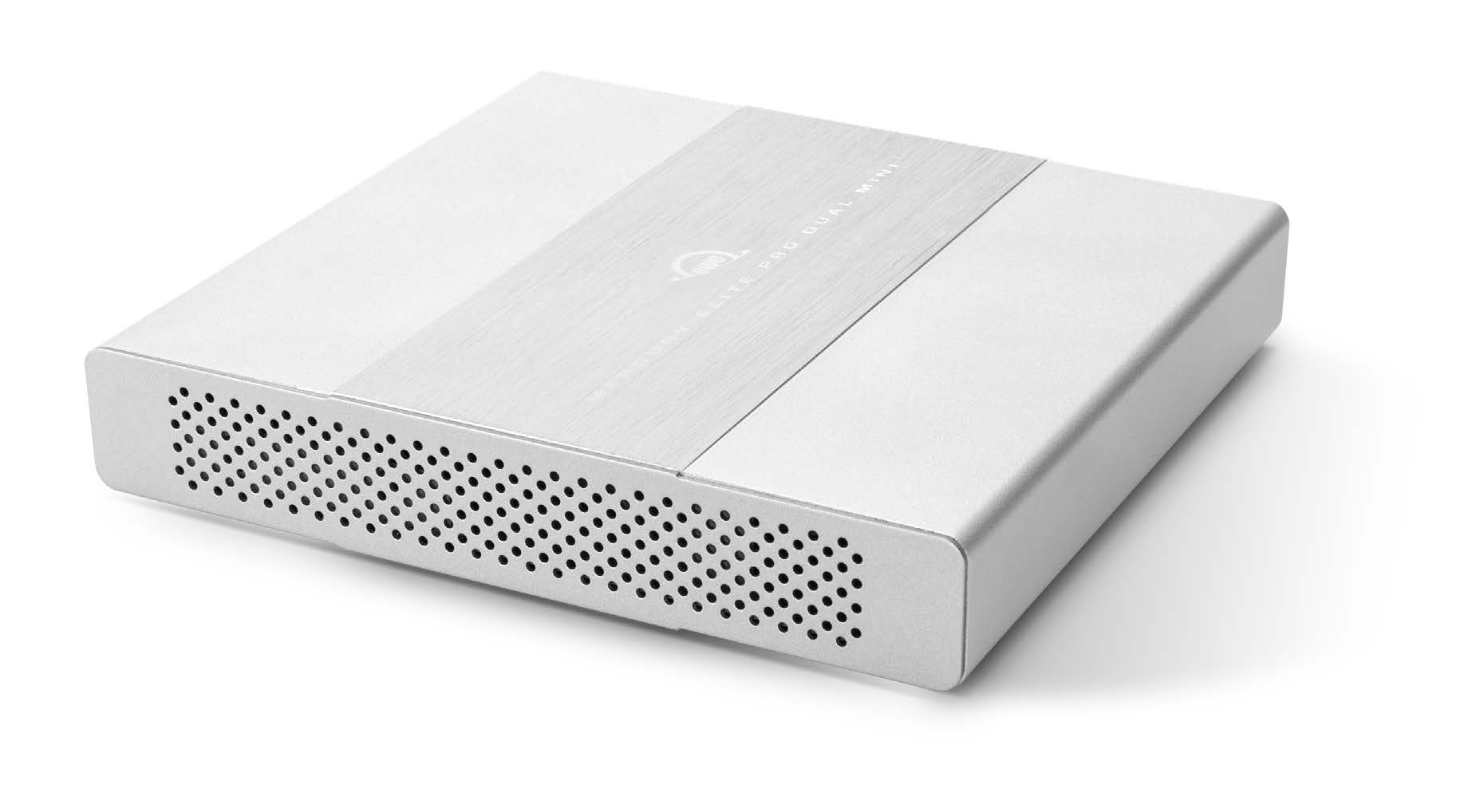
Introduction
1.1 System Requirements
Operating System & Hardware
- Works with any USB-C equipped:
- Mac: macOS 10.7 or later
- PC: Windows 7 or later
Supported Drives
- 2.5" SATA HDDs or SSDs up to 12.5mm in height
1.2 Package Contents
- (1) OWC Mercury Elite Pro Dual mini (USB 3.2 Gen2)
- (1) 0.5M (18") USB-C Cable
- (1) 0.5M (18") USB-A to USB-C Adapter Cable
- (1) External Power Supply and Power Cable
- (1) OWC Mercury Elite Pro Dual mini Getting Started QR Insert Card
1.3 Front View
1 & 2. LED Indicators – Power & Data Connection = Solid Blue | Data Activity = Blinking Blue | Drive Failure = Solid Red | RAID Rebuild = Blinking Blue & Red

1.4 Back View
1. RAID Dial & Set Button – Choose RAID mode with dial and set by pressing button
2. USB-C 3.2 Gen2 (10Gb/s) Port – Connect one of the included USB cables to this port
3. ON/OFF Switch - Toggle to power on and off
4. DC IN Power Port - Connect the included power supply if additional power is needed

Getting Started
2.1 Device Setup
- This section describes the process of setting up the OWC Mercury Elite Pro Dual mini if purchased with pre-installed drives (HDDs/SSDs installed from factory). The OWC Mercury Elite Pro Dual mini is available assembled with (2) SATA HDDs or SSDs configured as a hardware RAID 0. Please visit Section 2.3 "Hardware RAID Configuration" if there is a desire to change the hardware RAID mode.
1. Connect either the included 0.5M (18") USB-C cable or 0.5M (18") USB-A to USB-C Adapter Cable to the USB-C 3.2 Gen2 (10Gb/s) port on the back of the OWC Mercury Elite Pro Dual mini. Connect the other end of the cable into a compatible host.
2. Ensure the ON/OFF Switch is toggled to the ON position.
- NOTE: The ON/OFF Switch is receded, using a paper-clip or similar flat tool will be needed to toggle the ON/OFF Switch.
- OPTIONAL: Plug the power cable into the OWC Mercury Elite Pro Dual mini DC IN power port located on the back and into a power outlet if additional power is needed.
3. The OWC Mercury Elite Pro Dual mini comes formatted as APFS for Mac systems. This allows for a seamless plug-and-play experience on Mac systems. Connect the OWC Mercury Elite Pro Dual mini to a Mac and immediately begin using the drive.
- NOTE: Windows users will need to reformat the Mac formatted OWC device over that operating system to begin use. Please consult the support article "OWC Drive Setup Over Non-Apple Platforms" for instructions regarding reformatting the OWC Mercury Elite Pro Dual mini to work with Windows.
- NOTE: Please consult the Support Manual for OWC Drive Guide or Drive Guide Support Guide page for additional information regarding OWC Drive Guide.
2.2 Assembly Steps
- This section describes the process of installing a drive into the OWC Mercury Elite Pro Dual mini.
- NOTE: Opening the OWC Mercury Elite Pro Dual mini if pre-built (HDDs/SSDs installed from factory) will VOID the warranty. If you wish to remove or replace the drives after the expiration of the original warranty, you may do so at that time.
1. Set the Elite Pro Dual mini on a flat static-free work surface. Remove the (2) screws attached to the rear cover.
NOTE: The back plate will fall out of the enclosure once the screws are removed.

2. Grasp the front grill and gently pull the inner chassis from the outer enclosure.
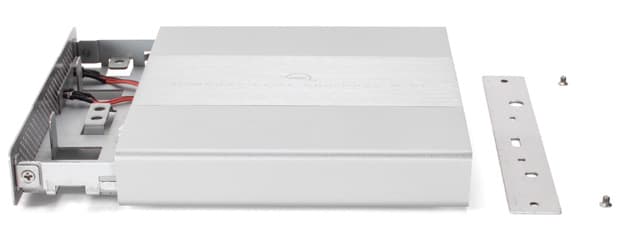
3. Pull the inner chassis the rest of the way out and remove the screw packet.
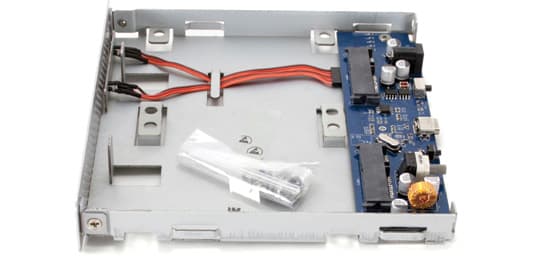
4. Hold the first SATA drive at a slight angle and line up the SATA connectors on the drive with the SATA ports on the printed circuit board, as shown. Once aligned, slide the drive into the ports just enough so the drive can be set down flat inside the inner chassis, as shown in Step 5.

5. Use your thumbs to gently press the drive forward, until it is fully connected to the SATA ports on the printed circuit board. Repeat Steps 4 and 5 with the second SATA drive.
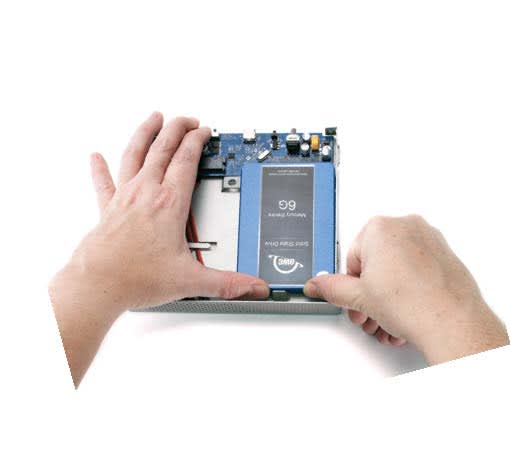
6. Flip the outer enclosure so that its rubber feet are facing up.
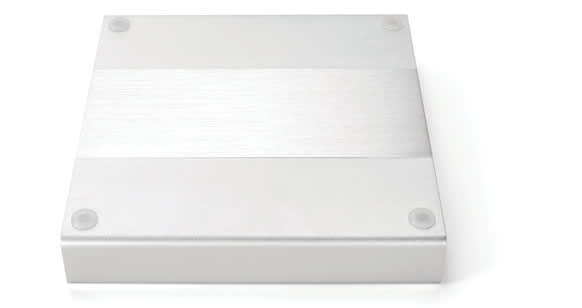
7. Turn the inner chassis over and set it on the outer enclosure so that the drives rest on two of the feet and slightly overhang the edge of the enclosure, as shown.
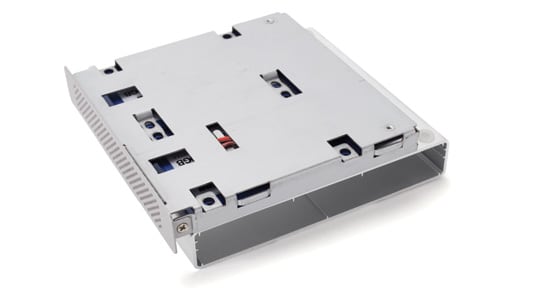
8. Take the larger screws from the packet and insert them in the row of screw holes at the back of the chassis, then partially tighten them.
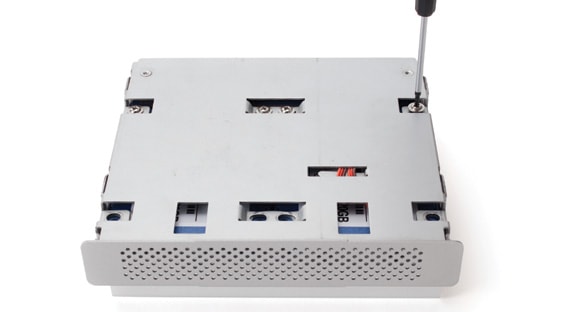
9. Take the rest of the large screws and insert them in the remaining screw holes, partially tightening them.

10. Turn the inner chassis over and visually inspect the two drives to ensure they are properly aligned before moving on to the next step.
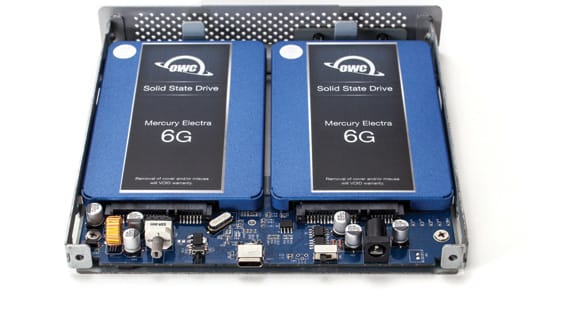
11. Turn the inner chassis over and set it on the outer case as before, then fully tighten all eight screws from Steps 8 and 9.
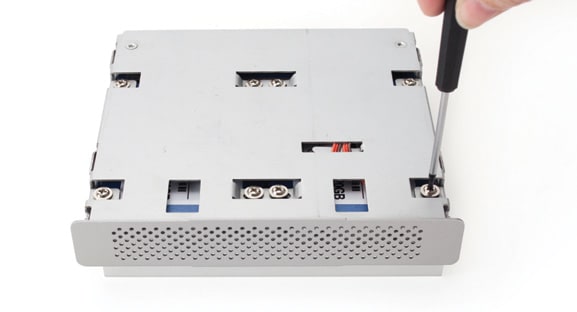
12. Set the inner chassis aside, turn the outer enclosure over and orient it as shown at right. Next, align the guides on the chassis with the guide rails in the enclosure. Note that the rails extend to the edge on only one side of the enclosure. Slide the chassis in until the front grill contacts the enclosure.
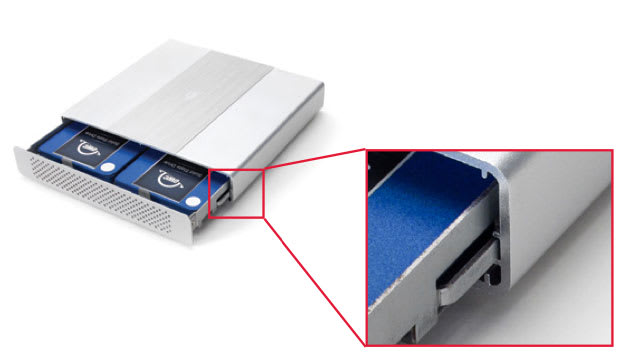
13. Pick up the rear cover, carefully align the cutouts with the ports on the back of the inner chassis, the re-affix the two screws.

14. The RAID mode of the OWC Mercury Elite Pro Dual mini will need to be configured. Please move onto the next section.
2.3 Hardware RAID Configuration
This section describes the process of configuring or reconfiguring the OWC Mercury Elite Pro Dual mini RAID mode.
NOTE: If there is any data on the drives being installed, changing the RAID mode will result in data loss.
- Connect either the included 0.5M (18") USB-C cable or 0.5M (18") USB-A to USB-C Adapter Cable to the USB-C 3.2 Gen2 (10Gb/s) port on the back of the OWC Mercury Elite Pro Dual mini. Connect the other end of the cable into a compatible host.
- Ensure the ON/OFF Switch is toggled to the ON position.
- NOTE: The ON/OFF Switch is receded, using a paper-clip or similar flat tool will be needed to toggle the ON/OFF Switch.
- OPTIONAL: Plug the power cable into the OWC Mercury Elite Pro Dual mini DC IN power port located on the back and into a power outlet if additional power is needed.
- Select the desired RAID mode by rotating the RAID dial using a paper-clip or similar flat tool. A slight click will be felt each time the arrow is aligned with a new RAID mode.
- The RAID mode is controlled by a dial near the bottom-right corner on the rear plate, in combination with the RAID set button which is just to the left of the dial.
- Once the RAID mode has been selected, using a paper-clip or pin, press and hold the RAID Set button for 3-5 seconds. The RAID mode will be set after releasing the button and the volume(s) are ready to be formatted.
NOTE: The button should remain pressed until the new volume(s) appear on the Desktop and/or a notice is displayed to format the new volume(s).- PC Users: The new volume(s) should appear in Disk Management.
- Mac Users: The new volume(s) should appear in Disk Utility and a notice will be displayed to format the new volume(s).
The installed drive is ready to be formatted.
RAID 0 “Drive Striping” Mode
- The two drives show up as a single large disk with a size equal to the combined capacities of both drives. RAID 0 is used when speed is the primary objective; it does not provide data redundancy for protection. The reading and writing of data files are spread across both drives to gain speed by distributing the workload. This allows for the fastest data transfer rates, but if one drive fails the whole array becomes corrupted. The data will be lost.
- Identical SATA drives (model, capacity, firmware) are required.
RAID 1 “Drive Mirroring” Mode
- The two drives show up as a single disk with a size equal to the capacity of a single drive from the array. RAID 1 copies (or “mirrors”) the data from the first drive to the second drive. This is useful when reliability and redundancy are more important than capacity or maximum speed. When one drive fails, it can be replaced, and the data can be rebuilt automatically from the other functioning drive. See Section 2.5 “Replacing Drives” for more details on the drive replacement and rebuild process.
- Identical SATA drives (model, capacity, firmware) are required.
Span Mode
- Both drives show up as a single large disk, but one which functions differently than RAID 0. The total size will depend on the drives installed; unlike RAID 0 or RAID 1 you can use drives of different capacities. A span is an array (but not a RAID) in which the data is written sequentially across the drives. When one drive becomes full, subsequent data is written to the second drive. This combines the capacities of the drives, but it does not provide any performance or data redundancy benefits.
Independent Drive Mode
- Each drive will appear individually without being combined. If you are using only one drive, this is the mode to use.
Device Management
3.1 Drive Failure
- If one of the SATA drives in RAID 1, 0, or Span fails (or is missing or not connected properly), the corresponding drive LED on the front of the device will light up a solid red.
- If the OWC OWC Mercury Elite Pro Dual mini was configured as a RAID 0, the data on the array is lost and the disk is no longer usable.
- When in Span, only the data stored on the failed drive is lost, although data recovery software will be required to retrieve the data from the other drive.
- If the drives were configured into Independent mode, then the data on the drive that did not fail will remain intact.
3.2 Replacing Drives
- If the OWC Mercury Elite Pro Dual mini is set up as a RAID 1, a drive that has failed can be replaced to rebuild the array. The data will remain accessible via the functioning drive until the array is rebuilt with a new drive.
- Drives being used as a RAID 0, Independent, or Span don’t have a rebuild option as the data is loss. If the enclosure was purchased with drives and it is still under warranty, contact OWC technical support for assistance (see Section 4.4 “Contacting Support”). If the unit is outside its warranty or was purchased without drives, follow the assembly instructions in Section 2.2 "Assembly Steps" to access and replace the failed drive.
- NOTE: A failed drive must be replaced with an identical drive (model, capacity, firmware)
- NOTE: The OWC Mercury Elite Pro Dual mini needs an active data signal to remain powered on. If it is disconnected from the computer, or if the computer goes to sleep or turns off, the device will power off. To minimize the rebuild time, it is recommended to keep the device connected to the computer (with the computer powered on), and disable any drive sleep settings on the computer for the duration of the rebuild. While rebuilding, the Drive LED indicator of the original drive has a blinking blue light, and the Drive LED indicator of the new drive will light up a solid red. The Drive LED indicator statuses will return to normal once the rebuild process is complete.
3.3 OWC Disk Performance
- As of Windows 10 v. 1809 the default Disk Removal Policy is ‘Quick removal’ instead of ‘Better performance’.
- NOTE: OWC storage solutions that are experiencing slow read/write speeds should consider checking and changing the Windows disk removal policy. Changing from "Quick removal" to "Better performance" can increase disk performance. OWC offers the application OWC Disk Performance to help change the Disk Removal Policy. Changing from "Quick removal" to "Better performance" can also be changed manually.
- Please review the support article Storage Solutions: OWC Disk Performance for more detail.
3.4 Manually Unmounting Volumes
- To ensure no data is lost during normal use, always eject or unmount the corresponding volume(s) from the operating system before powering off and disconnecting the device. Unmounting options are provided below.
macOS
- Drag the icon for the device you wish to unmount to the trash can; OR
- Right-click the device icon on the desktop, then click “Eject”; OR
- Highlight the device on your Desktop and press Command-E.
Windows
- Windows 10 build 1809 (October 2018) or later:
- Eject the drive by clicking the ‘Show hidden items’ menu in the Taskbar, then clicking ‘Safely Remove Hardware and Eject Media’, and last select the ‘Eject’ option for this volume.
- Windows 10 build 1803 and earlier:
- Go to the System Tray (located in the lower right corner of your screen). Click on the “Eject” icon (a small green arrow over a hardware image).
- A message will appear, detailing the devices that the “Eject” icon controls, i.e., “Safely remove...” Click on this prompt.
- You will then see a message that says, “Safe to Remove Hardware.” It is now safe to disconnect the device from the computer.
3.5 Usage Notes
- Identical SATA drives (model, capacity, firmware) are required for RAID 1 and RAID 0 configurations
- All Apple silicon Mac system users will experience 5Gb/s performance when connected directly over Thunderbolt. System Information will display the OWC Mercury Elite Pro Dual mini with a Device Connection of 5Gb/s.
- Connecting directly to a USB-C 3.2 Gen 2 port or through a dock’s Thunderbolt, USB-C, or USB-A 3.2 Gen 2 port will provide the advertised 10Gb/s.
- Mercury Elite Pro Dual mini is not compatible with the USB-C port on the OWC USB-C Dock. Please connect to one of the USB-A ports instead. Performance is identical on all USB ports on the USB-C Dock.
- If your USB host supports the USB Power Delivery 2.0 specification, it can bus-power the Mercury Elite Pro Dual mini. Other USB hosts may be able to bus-power this device as well. If you find that your chosen host does not bus-power the device, please use the included power supply.
- USB 3.1 Gen 2 (10Gb/s) and USB 3.2 Gen 2 (10Gb/s) are the same USB standard identification. Please view our Knowledgebase article USB Cable Standard and Speed Chart for more details.
Support Resources
4.1 Troubleshooting
- Verify the USB-C cable is securely connected between the OWC Mercury Elite Pro Dual mini and host.
- Connect the OWC Mercury Elite Pro Dual mini and host with a different USB-C cable.
- Connect the OWC Mercury Elite Pro Dual mini to a different host.
- Connect the included power supply.
- Users experiencing slow read/write speeds should consider checking and changing the Windows disk removal policy. Please review the support article Storage Solutions: OWC Disk Performance for more detail.
- We are very sorry If issues continue to occur. Please know that OWC support is here to help. Contact information for our support can be found in section 4.4 "Contacting Support". Please have your serial number ready which is located on the bottom of the OWC Mercury Elite Pro Dual mini and printed on the original packaging.
4.2 Online Resources
4.3 About Data Backup
To ensure that your files are protected and to prevent data loss, we strongly suggest that you keep two copies of your data: one copy on your OWC Mercury Elite Pro Dual mini and a second copy on either your internal drive or another storage medium, such as an optical backup, or on another external storage unit. Any data loss or corruption while using the OWC Mercury Elite Pro Dual mini is the sole responsibility of the user, and under no circumstances may OWC, its parents, partners, affiliates, officers, employees, or agents be held liable for loss of the use of data including compensation of any kind or recovery of the data.
4.4 Contacting Support
4.5 About This Manual
The images and descriptions may vary slightly between this manual and the unit shipped. Functions and features may change depending on the firmware version. The latest product details and warranty information can be found on the product web page. OWC’s Limited Warranty is not transferable and
General Use Precautions
- To avoid damage, do not expose the device to temperatures outside the following ranges:
- Environmental (Operating)
- Temperature (ºF): 41º — 95º
- Temperature (ºC): 5º — 35º
- Environmental (Non-Operating)
- Temperature (ºF): -4º — 140º
- Temperature (ºC): -20º — 60º
- Environmental (Operating)
- Do not use the device near other electrical appliances such as televisions, radios or speakers. Doing so may cause interference which will adversely affect the operation of the other products.
- Always unplug the device from the electrical outlet if there is a risk of lightning or if it will be unused for an extended period of time. Otherwise, there is an increased risk of electrical shock, short-circuiting or fire.
- Protect your device from excessive exposure to dust during use or storage. Dust can build up inside the device, increasing the risk of damage or malfunction.
- Do not block any ventilation openings on the device. These help to keep the device cool during operation. Blocking the ventilation openings may cause damage to the device and cause an increased risk of short circuiting or fire.
Safety Precautions
- Use proper anti-static precautions while installing drives into this enclosure. Failure to do so can cause damage to your drive mechanisms and/or the enclosure.
- To avoid any risk of electrical shock, fire, short-circuiting or dangerous emissions, never insert any metallic object into the device. If it appears to be malfunctioning, please contact technical support.
- Never expose your device to rain, or use it near water or in damp or wet conditions. Never place objects containing liquids on the drive, as they may spill into its openings. Doing so increases the risk of electrical shock, short-circuiting, fire or personal injury.
Terms & Conditions of Sale
Warranty
OWC’s products are subject to OWC’s Terms & Conditions of Sale located at Terms of Sale or other applicable terms. The OWC OWC Mercury Elite Pro Dual mini comes with a 3-Year Limited Warranty when sold with drives, and a 1-Year Limited Warranty when sold without drives. Additional warranty information can be viewed by visiting Hardware Warranties.
Changes
The material in this document is for information purposes only and subject to change without notice. While reasonable efforts have been made in the preparation of this document to assure its accuracy, OWC, its parent, partners, affiliates, officers, employees, and agents assume no liability resulting from errors or omissions in this document, or from the use of the information contained herein. OWC reserves the right to make changes or revisions in the product design or the product manual without reservation and without obligation to notify any person of such revisions and changes.
FCC Statement
Warning! Modifications not authorized by the manufacturer may void the user’s authority to operate this device.
NOTE: This equipment has been tested and found to comply with the limits for a Class B digital device, pursuant to Part 15 of the FCC Rules. These limits are designed to provide reasonable protection against harmful interference in a residential installation. This equipment generates, uses and can radiate radio frequency energy and, if not installed and used in accordance with the instructions, may cause harmful interference to radio communications. However, there is no guarantee that interference will not occur in a particular installation. If this equipment does cause harmful interference with radio or television reception, which can be determined by turning the equipment off and on, the user is encouraged to try to correct the interference by one or more of the following measures:
- Reorient or relocate the receiving antenna.
- Increase the separation between the equipment and receiver.
- Connect the equipment to an outlet on a circuit different from that to which the receiver is connected.
Copyrights and Trademarks
No part of this publication may be reproduced, stored in a retrieval system, or transmitted in any form or by any means, electronic, mechanical, photocopying, recording or otherwise, without the prior written consent of OWC.
© 2024 Other World Computing, Inc. All rights reserved. Mercury, OWC, and the OWC logo are trademarks of New Concepts Development Corporation, registered in the U.S. and/or other countries. Mac and macOS are trademarks of Apple Inc., registered in the U.S. and other countries. Thunderbolt and the Thunderbolt logo are trademarks of Intel Corporation in the U.S. and/or other countries. Other marks may be the trademark or registered trademark property of their owners.
Free Support Chat
Our free award-winning support team is ready to answer all of your questions. Technical support is available Monday - Friday: 9AM - 6PM. Customer Support & Sales is available Monday - Friday: 9AM - 6PM. Support is unavailable on U.S. Federal holidays. Talk to a human today.

 1-800-275-4576
1-800-275-4576